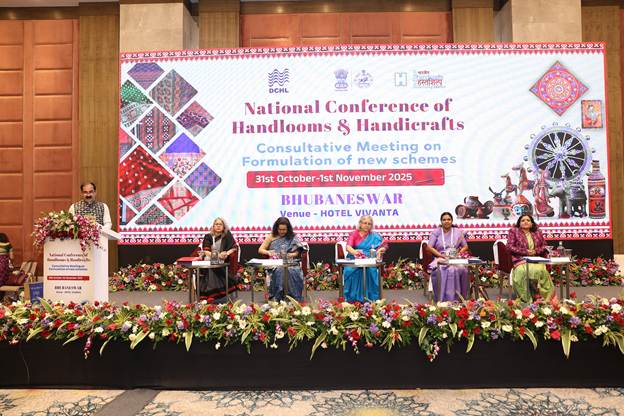National Conference on Handlooms & Handicrafts 2025 concludes at Bhubaneswar, Odisha
National Conference on Handlooms & Handicrafts 2025 concludes at Bhubaneswar, Odisha
The National Conference on Handlooms & Handicrafts 2025 concluded today in Bhubaneswar, Odisha, reaffirming the Government’s commitment to reimagining India’s handmade sector as a vital pillar of Viksit Bharat 2047. Organised by the Offices of the Development Commissioner (Handlooms) and Development Commissioner (Handicrafts), Ministry of Textiles, the two-day conference brought together senior officials from States and Union Territories, policymakers, and sector experts to chart a unified vision for the growth of India’s handloom and handicraft industries.

Deliberations centred around two key objectives: assessing the current landscape of the handmade economy and shaping the framework of a forthcoming national scheme aimed at deeper State participation, integrated governance, and sustainable sectoral development.
Smt. Neelam Shami Rao, Secretary , Ministry of Textiles, chaired the second day of the conference today, in the presence of Smt. Anu Garg, Additional Chief Secretary & Development Commissioner (Odisha), and Smt. Poonam Guha Tapas Kumar, Commissioner-cum-Secretary (Handlooms, Textiles & Handicrafts), Government of Odisha.
In her address, Smt. Neelam Shami Rao, Secretary (Textiles), emphasised the need to balance the traditional craftsmanship with modern tools to enhance productivity and reduce drudgery. The Secretary urged institutions such as the National Institute of Fashion Technology (NIFT) and the Indian Institute of Handloom Technology (IIHT) to take a proactive role in forecasting design and colour trends ahead of market cycles. Highlighting the importance of inter-State coordination, she called for seamless movement of raw materials across States to ensure efficient supply chains in the handicrafts sector. Concluding her address, she stated, “We must safeguard the very ecosystem we are nurturing. Whether we call it handloom or handicraft, it should not be seen as a peripheral part of our economy- it is, in fact, the premium product of the future.”

Smt. Neelam Shami Rao, Secretary (Textiles), also said that such conferences will be organised every six months to ensure continuous dialogue between the Central and State Governments, facilitate cross-learning of best practices, and review the progress of initiatives undertaken in the handloom and handicraft sectors. She reiterated that sustained coordination and periodic review are essential for achieving the shared vision of a resilient, inclusive, and innovation-driven handmade economy aligned with the goals of Viksit Bharat 2047.
Smt. Anu Garg reiterated the cultural and ecological value of handlooms, citing Kotpad and Dongria Shawls as sustainable examples. She called for greater recognition of artisans (including name-tagging on products), youth-oriented training in market research and product design, and announced plans for a Sustainability Cell and promotion of eco-textiles such as Katha Silk.
Dr. M. Beena, Development Commissioner (Handlooms), presented the blueprint for the National Traditional Textile Mission (2026–31)- a mission-mode approach aligned with Viksit Bharat 2047, emphasising cooperative federalism, skill and design upgradation, women-led development, cluster infrastructure, universal financial support for artisans, and innovation hubs for GI-linked branding.
Ms. Amrit Raj, Development Commissioner (Handicrafts), outlined governance reforms under the Mission, proposing a three-tier National-State-District model for decentralised, outcome-based implementation with strengthened digital governance and PMU-led impact monitoring.
The National Conference on Handlooms & Handicrafts 2025 was inaugurated on 31st October by Shri Manoj Ahuja, Chief Secretary, Government of Odisha, in the presence of Dr. M. Beena, Development Commissioner (Handlooms); Ms. Amrit Raj, Development Commissioner (Handicrafts); and Smt. Poonam Guha Tapas Kumar,Commissioner-cum-Secretary (Handlooms, Textiles & Handicrafts), Government of Odisha. Alongside the Conference, a Theme Pavilion showcasing the rich handloom and handicraft heritage of Odisha was curated at Taj Vivanta, Bhubaneswar. The Pavilion was inaugurated by Shri Manoj Ahuja.On the first day of the conference, six thematic sessions were held that highlighted State-level innovations and best practices aimed at holistic sectoral development.
Delegates also undertook a field visit to Kala Bhoomi, Boyanika and Utkalika showrooms to experience Odisha’s craft heritage.
The two-day deliberations reaffirmed a shared national commitment to create a cohesive, inclusive and innovation-driven ecosystem for artisans and weavers balancing tradition with technology and aligning with the objectives of Viksit Bharat 2047.